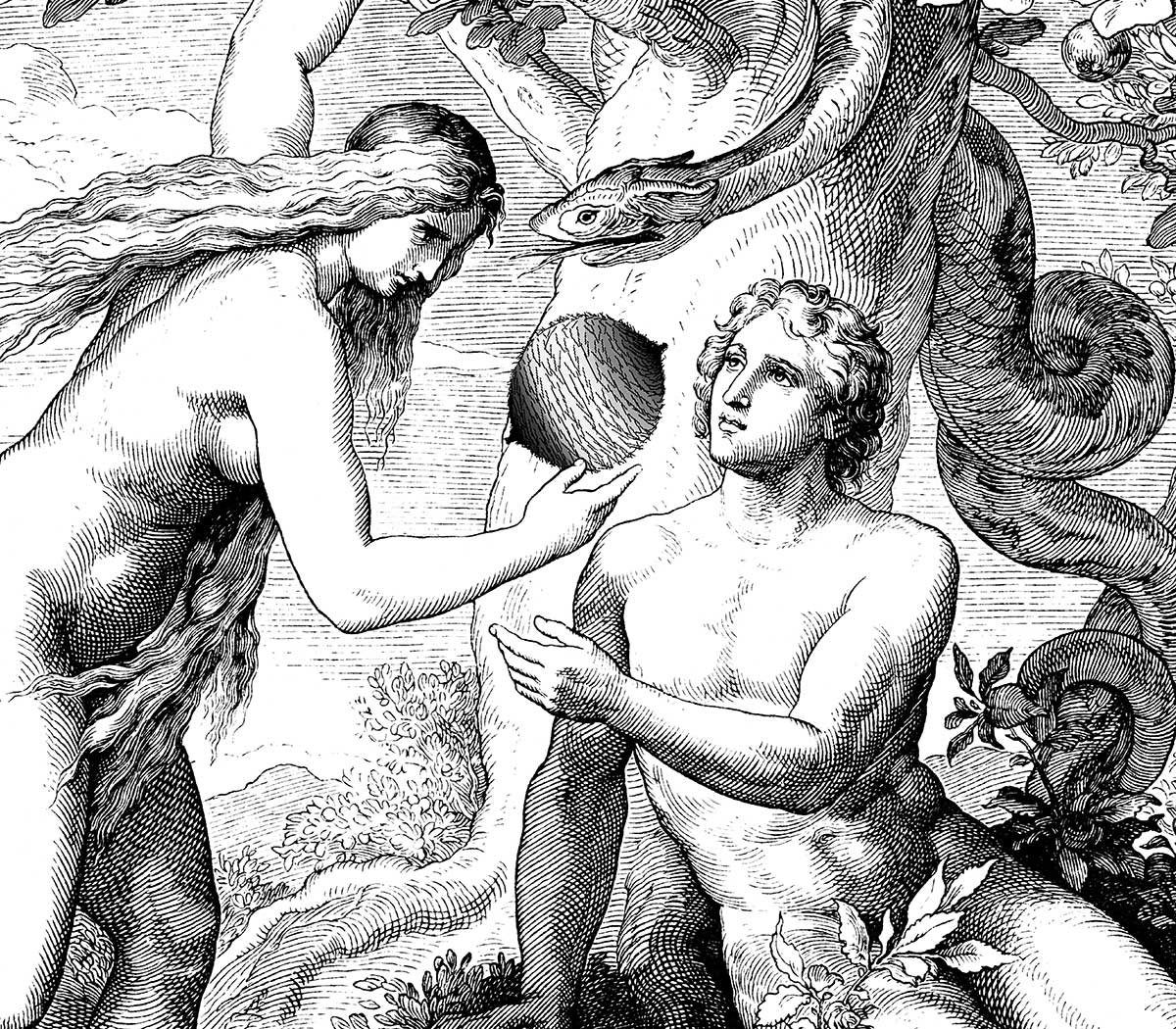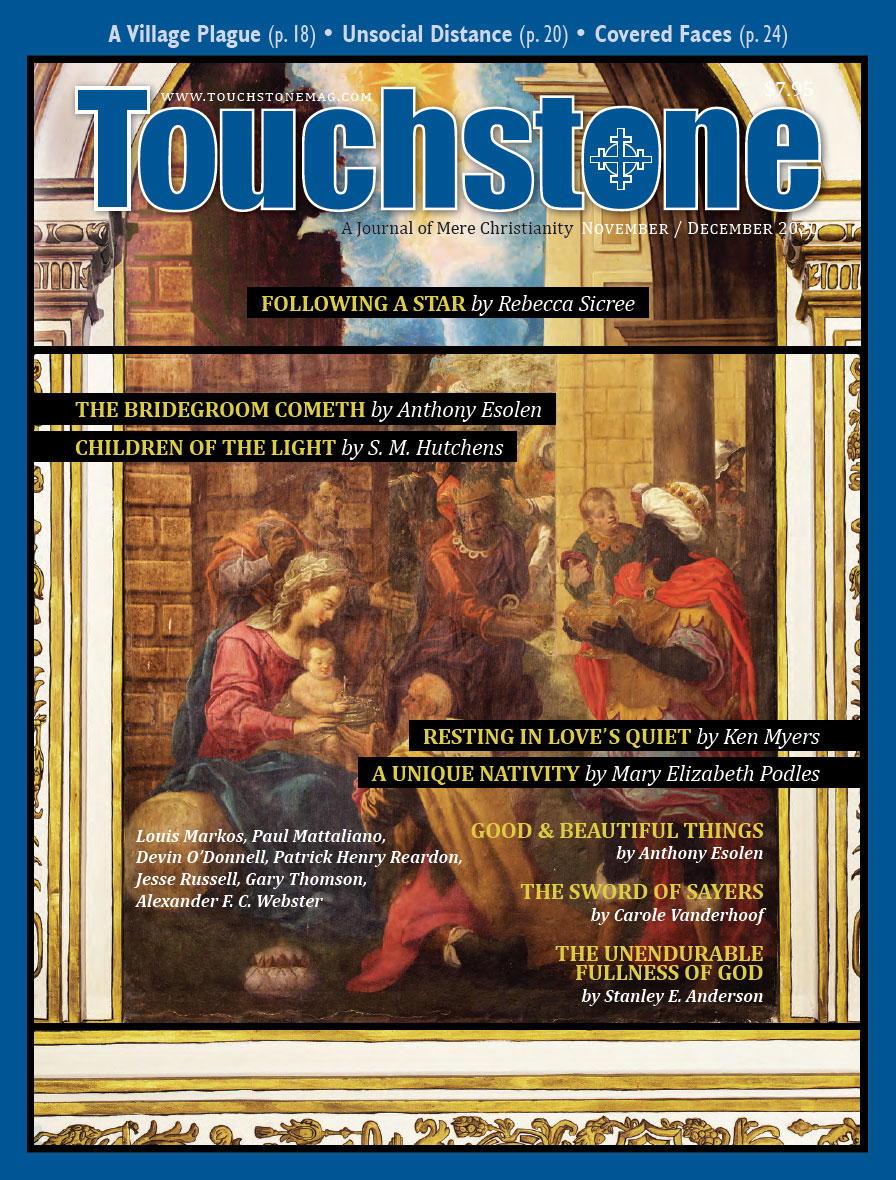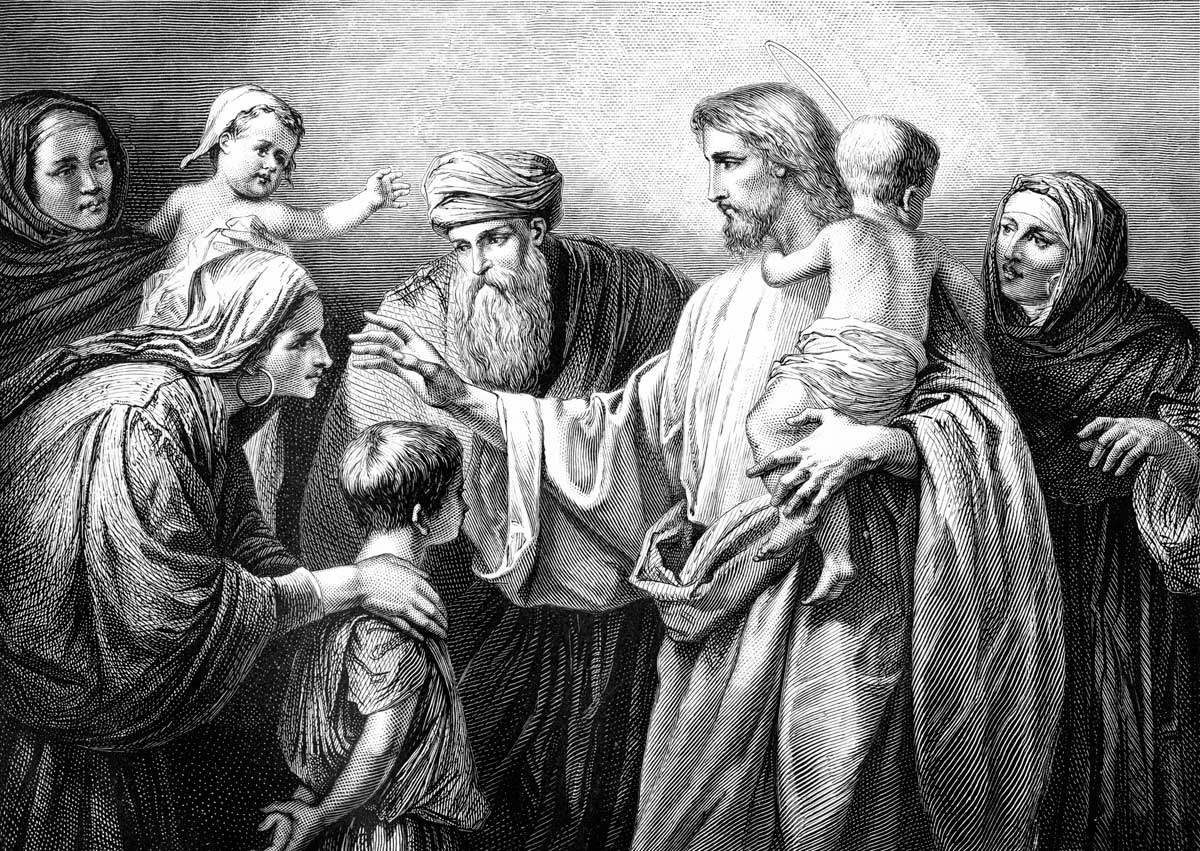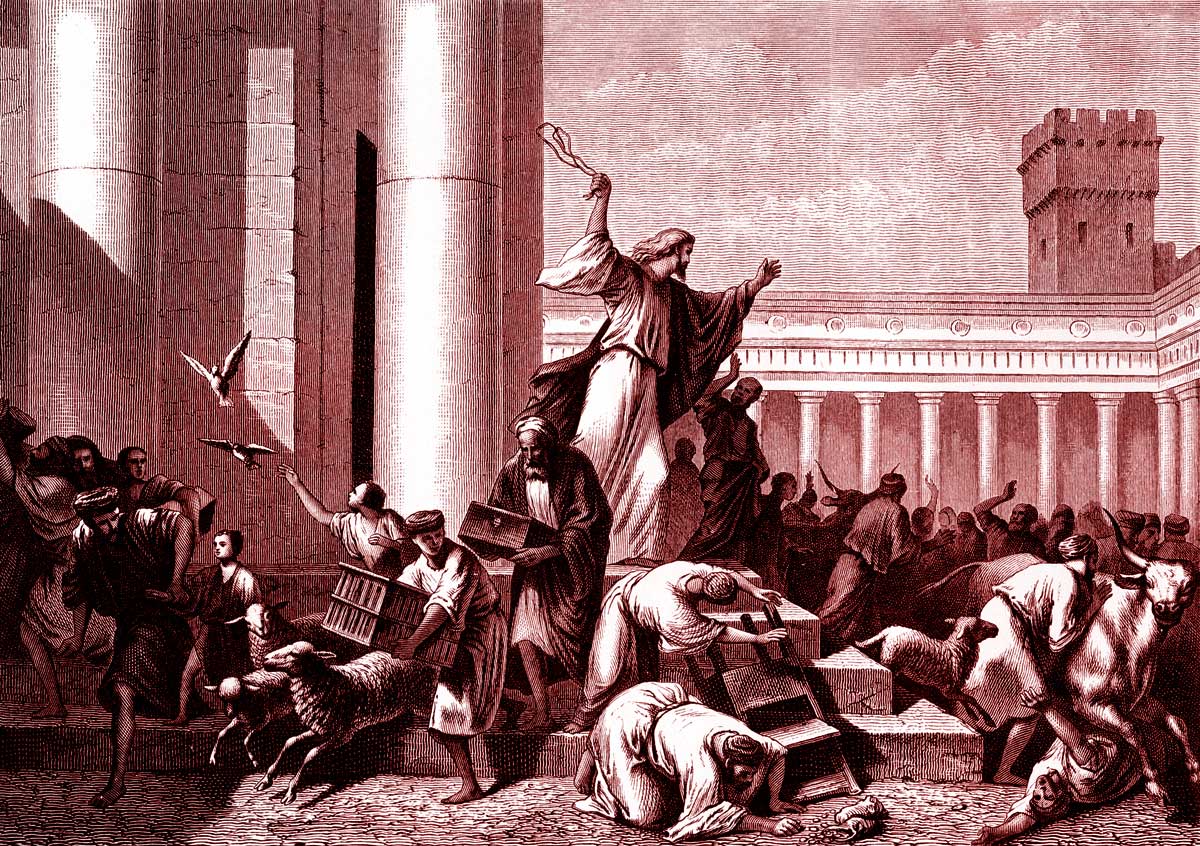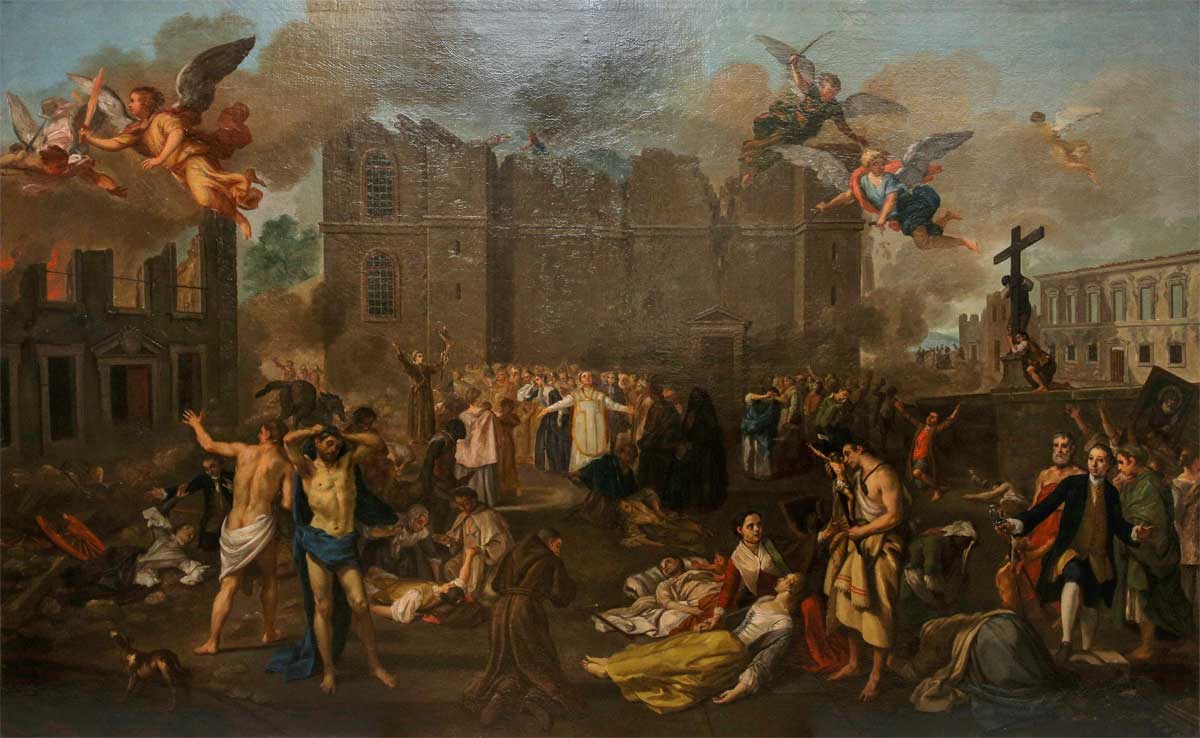Feature
The Unendurable Fullness of God
The Effects of the Fall as a Divine Protection Plan
An old newspaper comic strip, Arnold, shows student Arnold and his gullible friend Tommy standing behind a table. On the table are two electronic boxes with loose wires dangling from them. Arnold tells Tommy, "Guard my science project and don't touch those wires together or you'll get a shock. Remember, don't touch the wires." In the next two panels, Tommy contemplates the devices. The last panel shows Tommy holding the wires together in his hands with shock lines emanating from his jolted body and face. Arnold, having returned, says, "And they say the Garden of Eden is just a story."
In light of this observation, some might ask why God, as described in Genesis 2, would place the tree of the knowledge of good and evil in the garden to tempt man in the first place. One might wonder, "Did God want them to fail?" C. S. Lewis attempted to work around this complaint in the second book of his Space Trilogy, Perelandra. He argues in part that the heart of the prohibition (in the novel, staying overnight on "fixed land" is prohibited) lay in the availability of an act of pure obedience without seeming reason. But one might still wonder why "testing conditions" were required. Is an actual available choice for disobedience a "necessary evil" inherent to the gift of free will? Or is it merely God in his freedom doing it "because he could"? If the latter, the events can seem to have been orchestrated to foment disaster.
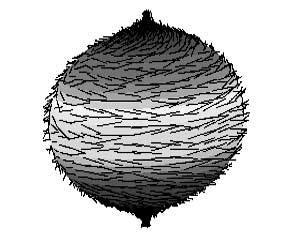
The Hairy Ball
The Hairy Ball Theorem in mathematics says, informally, "You can't comb a hairy ball flat without creating a cowlick." Imagine a dog's fur that can be petted "smoothly" from head to tail, but that offers resistance when petted in the opposite direction. The Hairy Ball Theorem proves that this kind of streamlined "directional fur" cannot smoothly cover the entire surface of a ball. There must be at least one point—typically many—where a disrupting "tuft" appears. And, curiously, this rather esoteric fact provides two useful analogies about good and evil in God's creation.
An easily envisioned "two-tufted" example of the hairy ball is a hypothetical global wind pattern blowing, say, from west to east, encircling an entire planet. The wind pattern is "smooth" everywhere except for two places, the north and south poles, like the eyes of two hurricanes. Smooth directional fur (having, similarly, two tufts, at the corresponding north and south poles) is easier to picture and describe than wind patterns and will serve best as a conceptual aid here.
Likening the Garden of Eden to this variation on the Hairy Ball of the theorem, the directional fur corresponds to the arena of trees in the garden of which Adam and Eve could "freely eat." Consider Adam and Eve likewise as "pliant patches" of similar directional fur on the surface of the hairy ball, able to "move about" by keeping their own fur aligned with the ball's fur (i.e., their free will aligned with God's will). In fact, the mere idea of not aligning with it would likely not occur to them. As long as they remain in obedience, i.e., anywhere except for the tufted poles, their obedience "lines up" with the pattern of God's will, and all is well.
By analogy, the tree of the knowledge of good and evil that Adam and Eve are commanded not to eat the fruit of corresponds to a "tuft" required by the Hairy Ball Theorem. By disobeying, Adam and Eve "move onto" the tufted area, ingesting it at, say, the ball's "north pole." But the intrinsically entangled discontinuity of the tuft doesn't allow for any kind of "smooth alignment"—and something must give. And since they have "consumed" this discontinuity into their very being, their own pattern can no longer align smoothly with God's will elsewhere, corresponding to the curse of death and sweat and sorrow in childbirth and tilling the ground for food that God said would occur as a result of their disobedience. One can almost envision a kind of rippling effect, like the wake of a powerboat in water, emanating from their own alignment-disruption wherever they go.
The main point of these fanciful imaginings is not so much to suggest "how," by analogy, the Fall or salvation came about in precise mechanical fashion, but to show that the presence of temptation for disobedience may be a required logical condition of the manner in which God brought Man and the Garden into existence, as opposed to God maliciously placing the forbidden fruit in the garden to foment disobedience.
The Torus
One might also wonder about further temptation—to wit, after salvation has culminated in the new heaven and new earth, could another equally "necessary" temptation for disobedience result in yet another Fall? We are told in Scripture that this is not the case, and that should certainly be authoritative enough for the faithful to allay any theoretical fears of this sort. But another aspect of the Hairy Ball Theoremprovides a useful analogy, too. The theorem applies to the surface of any simple solid with no "holes." In contrast, a donut-shaped torus has a hole in the middle, and thus does not share a sphere's topological requirement for a tuft. If, for example, directional fur points continuously along the torus like the encircling tread grooves on a tire, there will be no tufts and the torus will be smooth over its entire surface.
The two-tufted example for a sphere with "hurricane eyes at both poles" was used above primarily because examples of single-tufted patterns for a sphere are complex and difficult to visualize. But the two-tufted example also provides a convenient image for a "post-New-Creation" extension of the analogy. For there were two -special trees in the garden, the other one being the Tree of Life, which was perforce forbidden when Adam and Eve were banished from the garden after their disobedience. In the Hairy Ball analogy, if the Tree of the Knowledge of Good and Evil is represented by the tuft at the "north pole," the Tree of Life might be seen as the second tuft at the "south pole."
God's plan of salvation in Christ through his work on the Cross has long been seen as the sundered Tree of Life manifested in the fullness of time. In addition, by "taking on" the sins of mankind in his sacrifice, we might say that Christ encompasses both trees and brings them together, with salvation bursting forth in the Resurrection to draw sinners into eternal life.
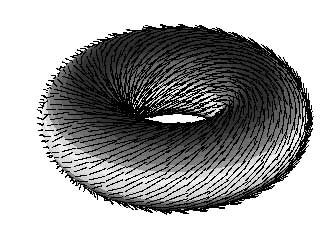
In the analogy, imagine the sphere as an elastic bubble that can be deformed, and that bringing those two trees together is seen as pushing the north and south poles inward toward each other until they "touch" at the center of the sphere. They merge and "open up" into a hole, changing the intrinsic shape of the sphere into a torus that can now support a directional fur (i.e., God's will) everywhere without any disorienting tufts to tempt God's redeemed creatures into disobedience. In other words, Christ's work on the Cross has effected the possibility of a new heaven and a new earth where "God shall wipe away all tears from their eyes; and there shall be no more death, neither sorrow, nor crying, neither shall there be any more pain; for the former things are passed away. And he that sat upon the throne said, Behold, I make all things new."
Again, these analogies are not intended as definitive explanations, but only to suggest unexpected avenues of possibility perhaps not previously considered. God and his creation are surely more robust than we can imagine, and we should never conclude that "difficult" scriptural passages "cannot be" simply because our limited and fallen view makes them seem impossible.
Guises of Evil
One of the puzzling aspects of the account of the Fall in Genesis is the very name of the tree with the forbidden fruit. Instead of simply "tree of good and evil," it is called the tree of "the knowledge of good and evil," implying that, before their disobedience, Adam and Eve could not distinguish between good and evil. So how could their act be "wrong" in a manner suggesting culpability, rather than simple error?
The Hairy Ball analogy above suggests that the unfallen Adam and Eve were able to walk with God, perhaps seeing only what was in alignment with God's will. In that fullness—surrounded, as it were, by God's will—any disruption or discontinuity or incompleteness itself would presumably not be apparent or even comprehensible to them from "within." God, being "outside" and able to "see" the created order in its entirety, warned them to avoid the tufted areas, but the results of trespassing the discontinuities would become physically apparent to them only after the result of not heeding the warning.
We picture stars and planets moving about in the vacuum of space. If we could achieve a perfect vacuum, for instance, inside a capped bottle, we might say that the bottle is empty and contains "nothing." But could we imagine a "nothing" that contains not even the "space" itself that "allows" physical objects to exist and move about within it? Perhaps this difficulty in conceiving of "nothing" as not even containing "empty space" has merit as a possible analogy of how Adam and Eve, before their disobedience and fall, did not have "knowledge" of good and evil.
Scripture presents evil in various guises. It would be foolish to subscribe to only one of these depictions of evil, since each depiction has its purpose in helping us understand evil. But one useful understanding of evil is the idea of it as "incompleteness" or "lack of fullness." To be sure, there are scriptural images that present evil as something we acquire or take on, like dirt that needs to be washed away. But purity or righteousness or salvation are also seen, in large measure, as images of "taking on" qualities; for example, putting on a garment that covers our sins. Adam and Eve did this, after a fashion, following their disobedience, in order to "hide" their shame at being naked, and knowing it as shame. If sin and evil are seen as "things unto themselves," there is a danger that the image of purity as a covering could seem like "whited sepulchers" or cups clean on the outside yet containing filth inside, images that Jesus used with disdain.
Even the concept of evil as "spoiled" goodness (e.g., fresh milk versus soured milk) is still understood as an arrangement "over there" that contrasts with the ordered or unspoiled arrangement "over here," a distinction with potentially dualistic ramifications of "this one good" and "that one bad." So both images of sin and evil, as filth and as spoiled goodness, can have hints of dualism. But if evil is seen instead as emptiness or incompleteness or a lack of fullness, the covering robes of righteousness can then be seen as a re-establishment of a depleted source. In other words, the Fall effectively resulted in the ability of Man to see the emptiness of a vacuum, that is, "nothing" as a thing unto itself—indeed, we can now hardly do otherwise.
I once saw a disturbing pair of images in a magazine. On the left was the face of a beautiful woman. On the right, a skull. The comparison was intended to show how the bone structure allowed the beautiful face to shine forth. But seeing the skull by itself, in contrast to the face, can make a viewer recoil in horror. A naïve reaction might be to suggest taking away the skull in order to remove the ugliness and horror. But the beautiful face without the internal bone structure would not result in a pretty-but-empty shell, but in an even more grotesque and horrid mass of unsupported flesh and organs collapsing into meaninglessness. The skull itself is not the source of the ugliness and horror; rather, the skull in isolation, without the fulfillment of its purpose, is horrible. It is this idea of incompleteness as a reduction from fullness that serves as a satisfying model of evil and sin. This view neatly eliminates the potential dualism inherent in "concrete" views of evil as a physical thing.
More Analogies for Incompleteness & Fullness
Analogies for this view of sin as incompleteness can be conceived at different levels, to accommodate various manifestations of evil as well as of goodness. The most basic form of incompleteness would be a simple "portion," like a half-empty glass or as in the relation between a skull and a face. Completeness might be restored by refilling a half-empty glass, or by adding missing organs and sinews and flesh to the skull, as in Ezekiel's valley of dry bones.
A more extreme form of incompleteness might be a "flattening" or geometrical reduction from the three dimensions of a solid object to a two-dimensional drawing or photo of the object. A perspective drawing of a brick cannot be "restored" in any normal sense to the solidity of an actual brick in the manner of refilling a half-empty glass, though visual cues of the drawing's perspective might well point to a conception of that fullness.
Moreover, higher-dimensional structures can have qualities that don't even exist for comparison in lower dimensions. For example, the curvature of a one-dimensional line, say, a spring or a twisted wire, can be measured by a single degree of "tightness," a quality identified as "linear." But curvature for two-dimensional surfaces can have two distinct forms, each of which has its own degree of "tightness." One is called "hyperbolic" (or "negative") curvature and is typically described as "saddle-shaped," where any attempt to flatten it creates folded-over areas because there is too much surface to spread out onto a flat area. The other is called "elliptical" (or "positive") curvature and is typically exemplified by an orange peel, where any attempt to flatten it creates tears in the surface because there is not enough surface to spread out onto a flat area.
These two distinct types of curvature for surfaces don't have any comparable counterpart in one-dimensional lines. The point here is that higher dimensions can support types of "fullness" that are not even recognizable from a lower dimensional point of view—making for a kind of "you had to be there" quality.
Fractal geometry creates even more complex notions of fullness. An object with a fractal nature has complexity and variety and structure embedded at many levels of "magnification" (even infinite levels in the purely mathematical Mandelbrot set). Typical examples of fractal complexity in art include the musical themes-within-themes-within-themes of a Beethoven symphony; or in the levels of composition and structure found in any portion, tiny or large, of Jan van Eyck's painting The Arnolfini Marriage; or in a medieval cathedral, with its designs of arches-within-arches-within-arches.
As a contrast, the "simplicity" of an iconic modern skyscraper might typically expose only a couple levels of structure—e.g., the overall rectangular shape of the building along with a sub-rectangular array of windows—and even those two levels are in nearly (and merely) strict imitation of each other. Disapproval of this modern "simplicity" might cast the structures as "ugly." Alternatively, one might suggest instead that the "beauty" of the modern skyscraper ends at, or is limited to, a meager two or three levels, and wearily self-similar levels at that. This is in contrast to the many levels of widely varying, yet resonating, similarity in the detail and structure of the other examples mentioned above. In this sense, a block of ice could be said to contain as much "fullness" of frozen water as possible, but its fullness would pale in comparison to the fullness of fractal complexity and detail embodied in a snowflake's beauty.
These examples are intended only to illustrate the potential variety and richness of "fullness" as contrasted with "incompleteness," along with the idea of evil as "incompleteness," where the "knowledge of good and evil" lies in a conscious perception of incompleteness. As the yet-unfallen Adam and Eve "walked with God," they seemingly did not—presumably could not at that stage—sense incompleteness. They were surrounded by God's "fullness," and, like the contemplation "Does a fish know that it swims in water?", they walked in the midst of that fullness in the garden, sensing only the fullness of God's will around them as "the way things are."
Two Manners of Fullness
A distinction can be made here. We might suppose that even in their unfallen state, Adam and Eve were themselves as yet "incomplete." But there are at least two distinct manners of "fullness" that can be considered here. One is a restoration after a departure from fullness, such as happens when, say, a glass half-full from a previous full state, is refilled. The "emptying" process is a form of incompleteness that I have here associated with the notion of evil and its connection to a fallen world.
The other is a notion of life and growth that occurs in a positive "fulfillment" fashion. For example, a seed might be as "full" as it can be in its present state, but it has the potential for more fullness than its current state can even hint at. A person who has never seen a tree could not conceive what form an acorn seed might take after it was planted. He might possibly imagine it becoming a larger and larger seed. But roots and branches and leaves and flowers would presumably never enter his imagination (recall the distinct positive "orange peel" curvature and negative "saddle-shaped" curvature of two-dimensional surfaces for which the singular curvature of a one-dimensional line has no recognizable counterpart).
This notion of a developing fullness in life and growth might allow Genesis to tell us, "And they were both naked, the man and his wife, and were not ashamed." Their nakedness at this stage was as "full" as they could be at that stage, yet there was also unrecognized incompleteness. They would be subject to "pure" obedience, relying only on trust, as C. S. Lewis's setting in Perelandra describes.
Alas, that grander form of completeness was not to occur in a straightforward fashion after they succumbed to the serpent's temptation. We might see that temptation as an attempt to "separate" God's fullness into parts, as it were—i.e., the serpent said, "your eyes shall be opened, and ye shall be as gods." In their incompleteness, they could not imagine being "like" God in his fullness unless they could somehow fashion him in their minds as "partial" or incomplete. In any case, the result of their disobedience in gaining "knowledge of good and evil" would presumably also include a newly acquired recognition of their own incompleteness, giving weight to the report of their immediate awareness and sense of shame when "they knew they were naked" and sewed fig leaves to cover themselves.
Perhaps that fear—maybe even horror—was not unlike the earlier example of a skull separated from its fullness. That horror might result in their attempt to now artificially "re-fill" their incompleteness by covering themselves with clothes or hiding from God among the trees that he had created for them to enjoy rather than hide among. Their disobedience of course resulted in their banishment from the garden and subjection to pain, suffering, and death.
Fallen Time
As I have suggested elsewhere, it may be that our experience of time itself became "fallen" and limited to a strictly linear progression by their disobedience. In his Narnian story, The Silver Chair, Lewis describes "Father Time" as a giant who is asleep underground, but will awaken at the end of the world. This might be a good description of what our own linear "asleep" (and therefore "fallen") time is like in comparison to a "fully awake" awareness of the "fullness of time." That fullness is something we, being trapped or confined in this sleepy linear temporal prison, can hardly conceive of, just as we don't recognize in sleep that we are dreaming, but when we awaken we are able to recognize both wakeful (i.e., a kind of fullness itself) and dreaming (i.e., incomplete) states.
But as an attempt to partially understand an idea of the "fullness of" or "awakened" time, we might compare it to the contrast between our aesthetic enjoyment of hearing music as a strictly linear progression of sounds in time, moment by moment, to viewing a painting or sculpture "as a whole" at a glance. After a piece of music is over, we can look back in memory to "see" it in our minds in its wholeness. But before that, we can only "take it as it comes." A painting, however, is not linear in that way to our sight. Instead, we see the image in its fullness at once, like a master chess player who "takes in" the state of the positions "at a glance" and as a whole.
Still, so encompassing is our imprisonment in linear time that even our vision leans toward the linear—e.g., a masterly composition in a painting can still lead our attention around the image in a linear fashion to evoke aesthetic reactions in a sequential fashion, too. But just as a perspective drawing of a cube points to what a solid cube is like, we can perhaps catch a glimmer of what the "wholeness" of time itself might be like, even though we cannot experience it directly in this fallen state.
Confinement as Protection
In addition, rather than seeing fallen confinement (both in time and in exclusion from the garden) strictly as "punishment," we might see it instead as protection for fallen man imposed by God to guard us from the ultimate effects of the Fall. What if, as a result of the Fall, this new awareness of incompleteness and emptiness would create utter and supernatural terror for us were we to now gaze upon the fullness of God's glory and will and creation? Perhaps even a terror so intense as to lead to man's unmaking: as God told Moses, "Thou canst not see my face, for there shall no man see me, and live."
An acquaintance recently described experiencing a curious effect after finally getting a much-needed hearing aid. He wrote:
Wearing a hearing aid for the first time brings many sensory surprises. One of them is that you often think something is wrong; when the whole world suddenly sounds different, it means the whole world suddenly sounds "wrong," and you have to train your mind to quit going on alert at every unaccustomed impression. . . . I even hear air in ways I'm not accustomed to hearing it, which sparks the inner alert that maybe the gas is on on the stove.
Imagine amplifying this alarm-effect a thousand-fold, and you may have an appreciation of why God may have "separated" us (for the time being) from the potential "unmaking" terror of perceiving God's ultimate goodness.
Thus, God might prevent fallen man from seeing that fullness by allowing only a forced-march-forward step of time, moment by moment. We see at most a "backward glance" into the past, but we have no definite ability to see the end result—the future— to which the journey is leading (though if we are fooled into thinking that this linear forced march is "all there is" to time, we can easily be led into despair and weariness, not only at the idea of dying, but even at the idea of "living forever" in a linear fashion).
Even our perception of space may have been "emptied" of the same manner of otherwise unbearable terror. Perhaps our view of both time and the universe as billions of linear years in the past and billions of light-years of empty space "out there" is God's protection of us from a fullness that only our redeemed and resurrected bodies will be able not only to bear, but to glorify and praise God in.
Hints of Glory & Fullness
In Lewis's Out of the Silent Planet, the protagonist, Ransom, while on a forced voyage in a spaceship to Mars, experiences a hint of this glory and fullness after realizing that "at the back of his thinking for years had lurked the dismal fancy of the black, cold vacuity, the utter deadness, which was supposed to separate the worlds." But then, sensing some bit of the fullness lurking behind its disguise of emptiness and vacuum, he realizes that "Space was the wrong name—older thinkers had been wiser when they named it simply the heavens—the heavens which declared the glory."
Later, in the sequel Perelandra, Ransom senses both an overburdened horror and the glory of fullness (in measured doses), according to his outlook, after conversing with the so-far-unfallen woman on Venus. He describes this dichotomy to his friends back on Earth:
At first it was almost intolerable; as he put it to us, in telling the story, "There seemed to be no room." But later on, he discovered that it was intolerable only at certain moments—at just those moments in fact . . . when a man asserts his independence and feels that now at last he's on his own. When you felt like that, then the very air seemed too crowded to breathe; a complete fullness seemed to be excluding you from a place which, nevertheless, you were unable to leave. . . . But when you gave in to the thing, gave yourself up to it, there was no burden to be borne. It became not a load but a medium, a sort of splendour as of eatable, drinkable, breathable gold, which fed and carried you and not only poured into you but out from you as well. Taken the wrong way, it suffocated; taken the right way, it made terrestrial life seem, by comparison, a vacuum.
In this earthly life we are perhaps only capable of experiencing horror at that intolerable, suffocating, overburdened, and claustrophobic sense of "no room" in the presence of the fullness of God's creation. It might be that, in our fallen state, we can only endure the protection of a seemingly "emptied" universe to our "flattened" senses. But why the unremembered and seemingly unendurable eons of time in the past, along with unthinkable spans of empty space of billions of light-years distant? The simple answer may be that so full are they in their hidden, actual fullness, that to "unpack" or "unfold" them in a linear fashion produces such numbers. Remember that in Einstein's space-time continuum, time is a kind of linear variation of the other three dimensions (the speed of light being the conversion factor), where one second of time is equivalent to 186,000 miles of distance.
If we can hardly cope with numbers and quantities like this for empty space and linear time, would their fullness in a redeemed state be unbearable unless they were at least partially (if not virtually entirely) hidden from view? Adam and Eve's banishment from the garden may have been a protection from an unendurable fullness, let alone an infinite "living forever" lifespan. This nightmare of linear distance and time would be in contrast to an entirely different manner of "eternal life" that we might experience in the Resurrection, when our redeemed bodies are capable of "taking it in." Consider the paradoxical nature of Lewis's paradisiacal garden at the end of his Narnian book The Last Battle, where we read that "the inside is larger than the outside." Perhaps "size" becomes a completely different thing in the Resurrection.
Seeking Fullness in Faith & Love
In any case, God is not willing to let us be content with mere scarcity, the near-vacuum that remains in place of the fullness of his creation. He has made sure that we have not been completely blinded to that fullness. Instead, he has given us (if we choose to accept the gift) the opportunity to trust in and to praise him, and especially (even if only partially in our fallen state) to participate in his will without fully "seeing" or experiencing it. We are told, "For now we see through a glass, darkly; but then face to face: now I know in part; but then shall I know even as also I am known."
So though this limitation of linear time and "empty" space and the diminution of the disastrous effects of Man's disobedience might be seen as protection, God does not then merely leave us in that state. He gives us an ability to trust that this scarcity is not all there is and that, with our determination and dedication, we can seek his fullness in faith. God also gives us a seemingly in-born desire for that fulfillment, even though we don't know it in fullness. Lewis called it, coining a special meaning for the word, "Joy," and described it before his conversion as an intense longing for "I know not what." He describes how he could only discern, often through painful trial and error, that the object of that desire is not to be found in earthly things. Scripturally we might see his Joy as a kind of pre-conversion description of scriptural hope, which is only awaiting the knowledge of its yet-to-be-found true object of intense desire, God.
Finally, God also gives us the ability to participate in his will in this world, even if only partially in our fallen state. For we can, directed by his Word and the authority and teaching of his Church, do acts of goodness outside of ourselves for the benefit of others without expectation of reward. This is what Scripture calls "love," the greatest of the three things that remain: faith, hope, and love. Praise and glory to God, who draws goodness out of evil. Our ability to enact that love is born out of the ashes of disobedience. For with the "knowledge of good and evil," we can discern and thus combat evil by filling that emptiness with acts of goodness toward our fellow creatures with that greatest thing, love.
Stanley E. Anderson holds a degree in mathematics and has worked in data analysis, IT, and quality assurance in the aerospace industry. He and his wife are converts from Anglicanism to the Catholic Church.
subscription options
Order
Print/Online Subscription

Get six issues (one year) of Touchstone PLUS full online access including pdf downloads for only $39.95. That's only $3.34 per month!
Order
Online Only
Subscription

Get a one-year full-access subscription to the Touchstone online archives for only $19.95. That's only $1.66 per month!
bulk subscriptions
Order Touchstone subscriptions in bulk and save $10 per sub! Each subscription includes 6 issues of Touchstone plus full online access to touchstonemag.com—including archives, videos, and pdf downloads of recent issues for only $29.95 each! Great for churches or study groups.
Transactions will be processed on a secure server.
more on Christianity from the online archives
more from the online archives
calling all readers
Please Donate
"There are magazines worth reading but few worth saving . . . Touchstone is just such a magazine."
—Alice von Hildebrand
"Here we do not concede one square millimeter of territory to falsehood, folly, contemporary sentimentality, or fashion. We speak the truth, and let God be our judge. . . . Touchstone is the one committedly Christian conservative journal."
—Anthony Esolen, Touchstone senior editor





